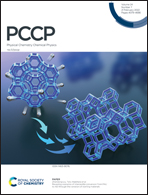Ultra-low lattice thermal conductivity and anisotropic thermoelectric transport properties in Zintl compound β-K2Te2†‡
Abstract
A good thermoelectric (TE) performance is usually the result of the coexistence of an ultralow thermal conductivity and a high TE power factor in the same material. In this paper, we investigate the thermal transport and TE properties of the Zintl compound β-K2Te2 based on a combination of first-principles calculations and the Boltzmann transport equation. Remarkably, the calculated lattice thermal conductivity κL in hexagonal β-K2Te2 is ultralow with a value of 0.19 (0.30) W m−1 K−1 along the c (a and b) axis at 300 K due to the small phonon group velocity and phonon lifetime, which is comparable to the κL for wood and promises possible good TE performance. By taking the fully anisotropic acoustic deformation potential scattering, polar optical phonon scattering, and ionized impurity scattering into account, the rational electron scattering and transport properties are captured, which indicates a power factor exceeding 2.0 mW m−1 K−2. As a result, the anomalously high n-type ZT of 2.62 and p-type ZT of 3.82 at 650 K along the c axis are obtained in the hexagonal β-K2Te2, breaking the long-term record of ZT < 3.5 in the majority of the reported TE materials until now. These findings support that hexagonal β-K2Te2 is a potential candidate for high-efficiency TE applications.



 Please wait while we load your content...
Please wait while we load your content...